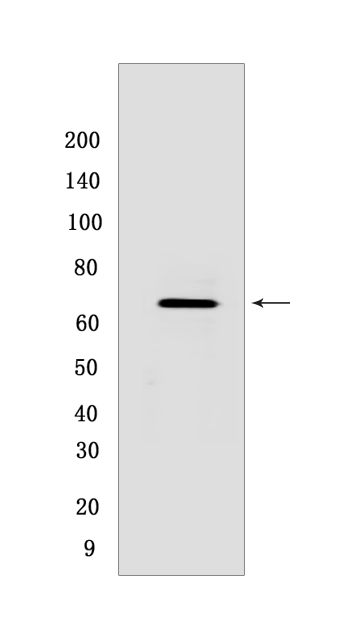EIF2AK1 Mouse mAb[1307]Cat NO.: A33383
Western blot(SDS PAGE) analysis of extracts from MCF-7 cells.Using EIF2AK1 Mouse mAb IgG [1307] at dilution of 1:1000 incubated at 4℃ over night.
Product information
Protein names :EIF2AK1,HRI,KIAA1369,PRO1362,E2AK1_HUMAN,Eukaryotic translation initiation factor 2-alpha kinase 1
UniProtID :Q9BQI3
MASS(da) :71,106
MW(kDa) :71kDa
Form :Liquid
Purification :Protein A purification
Host :Mouse
Isotype :IgG
sensitivity :Endogenous
Reactivity :Human
- ApplicationDilution
- 免疫印迹(WB)1:1000-2000
- 免疫组化(IHC)1:100
- The optimal dilutions should be determined by the end user
Specificity :Antibody is produced by immunizing animals with a synthetic peptide of human EIF2AK1.
Storage :Antibody store in 10 mM PBS, 0.5mg/ml BSA, 50% glycerol. Shipped at 4°C. Store at-20°C or -80°C. Products are valid for one natural year of receipt.Avoid repeated freeze / thaw cycles.
WB Positive detected :MCF-7 cells
Function : Metabolic-stress sensing protein kinase that phosphorylates the alpha subunit of eukaryotic translation initiation factor 2 (EIF2S1/eIF-2-alpha) in response to various stress conditions (PubMed:32132706, PubMed:32132707). Key activator of the integrated stress response (ISR) required for adaptation to various stress, such as heme deficiency, oxidative stress, osmotic shock, mitochondrial dysfunction and heat shock (PubMed:32132706, PubMed:32132707). EIF2S1/eIF-2-alpha phosphorylation in response to stress converts EIF2S1/eIF-2-alpha in a global protein synthesis inhibitor, leading to a global attenuation of cap-dependent translation, while concomitantly initiating the preferential translation of ISR-specific mRNAs, such as the transcriptional activator ATF4, and hence allowing ATF4-mediated reprogramming (PubMed:32132706, PubMed:32132707). Acts as a key sensor of heme-deficiency: in normal conditions, binds hemin via a cysteine thiolate and histidine nitrogenous coordination, leading to inhibit the protein kinase activity (By similarity). This binding occurs with moderate affinity, allowing it to sense the heme concentration within the cell: heme depletion relieves inhibition and stimulates kinase activity, activating the ISR (By similarity). Thanks to this unique heme-sensing capacity, plays a crucial role to shut off protein synthesis during acute heme-deficient conditions (By similarity). In red blood cells (RBCs), controls hemoglobin synthesis ensuring a coordinated regulation of the synthesis of its heme and globin moieties (By similarity). It thereby plays an essential protective role for RBC survival in anemias of iron deficiency (By similarity). Similarly, in hepatocytes, involved in heme-mediated translational control of CYP2B and CYP3A and possibly other hepatic P450 cytochromes (By similarity). May also regulate endoplasmic reticulum (ER) stress during acute heme-deficient conditions (By similarity). Also activates the ISR in response to mitochondrial dys HRI/EIF2AK1 protein kinase activity is activated upon binding to the processed form of DELE1 (S-DELE1), thereby promoting the ATF4-mediated reprogramming (PubMed:32132706, PubMed:32132707)..
Tissue specificity :Expressed predominantly in erythroid cells (PubMed:20071449). Expressed at much lower levels in hepatocytes (at protein level) (PubMed:20071449)..
IMPORTANT: For western blots, incubate membrane with diluted primary antibody in 1% w/v BSA, 1X TBST at 4°C overnight.


